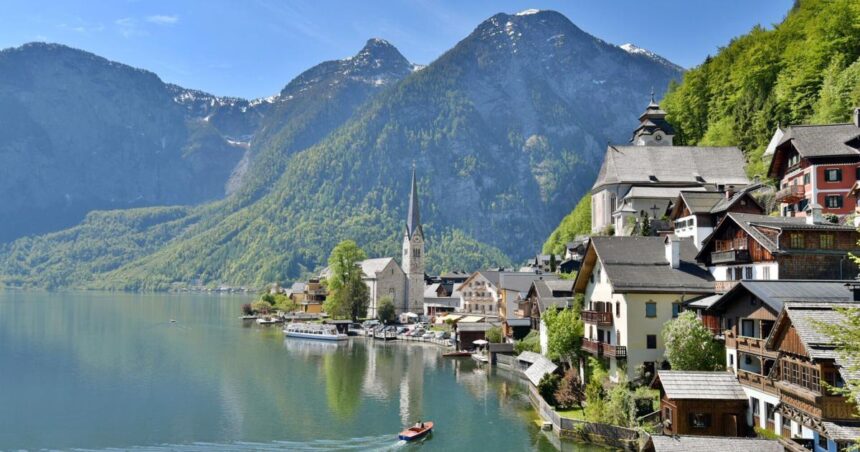Waking up early is a rare occurrence for me, but the picturesque town of Hallstatt, nestled by the lake and located two hours south of Salzburg, has the charm to make it happen. As I start my day, I head to the upper part of town to admire the tranquil waters of Lake Hallstatt. The reflection of the town’s church spire in the calm water is a sight to behold, especially when a shuttle boat disrupts the peace with its passage, creating a ripple in the serene setting.
Hallstatt lies in Austria’s Salzkammergut lake region, a scenic paradise that has captivated nature enthusiasts for generations. This area is reminiscent of the scenes from the movie Sound of Music – beautiful and majestic, yet not rugged. It is a gentle land where lakes and mountains blend together harmoniously.
Before Rome, there was Hallstatt. One of the oldest settlements in Europe, Hallstatt originally served as a center for salt mining (its name meaning “place of salt”). Beneath some of the buildings, you can find Roman and pre-Roman Celtic pavement stones from ancient salt depots. Archaeologists suggest that people have been coming here for salt since 7,000 BC, as salt was a valuable commodity for preserving meat over the centuries.
People are also reading…
A funicular takes visitors up the mountain to the town’s salt mine, which is one of the many mines in the region offering guided tours. At the mine, visitors don overalls, meet their guide, and venture deep into the mountain to learn about the history of salt mining. A highlight of the tour is sliding down long banisters between floors like a miner, hoping to avoid splinters.
While tourism has impacted some of Hallstatt’s charm, the town still preserves vivid cultural traditions. Traditional green felt hats adorned with decorative feathers are popular in Austria. On my initial visit as a teenager, my dad and I each bought a hat and playfully filled them with souvenir pins and fancy feathers. Decades later, during the annual feather-in-the-hat party, I witnessed local men, sporting finely carved pipes and handlebar mustaches, proudly showcasing their hats and feathers while dressed in lederhosen.
For centuries, Hallstatt was inaccessible by road, and transportation relied on boats. The traditional Fuhr boats, flat and wide to navigate shallow waters, were used to transport salt. During a recent visit, a local friend treated me to a boat ride in his Fuhr. As he expertly rowed with a single oar, he remarked, “An hour on the lake feels like a day of vacation.” He explained that the oar lock, resembling a doughnut made from a bull’s gut, was crucial for rowing smoothly.
Overlooking the lake is Pension Hallberg, featuring artifacts retrieved from the bottom of Lake Hallstatt. Among the intriguing finds are remnants of Nazi paraphernalia, including war medallions. The explanation provided shed light on this unusual discovery: as Germany faced defeat in World War II, individuals associated with the Third Reich disposed of their medals in the lake as a means of discarding them.
In Hallstatt, a warm welcome often involves the offer of cooking a fish for a guest. I vividly recall the morning fish-selling routine, where a young boy methodically chose trout from a pen and swiftly dispatched them with a quick blow to the head. The trout were then taken to a nearby fishery where they were gutted by another individual. A cat waited expectantly, anticipating a hearty meal. Residents and tourists alike lined up to purchase fresh trout for meals or as gifts.
Restaurant Bräugasthof, situated by the lakeside under a majestic chestnut tree, is the perfect spot to savor the renowned fish from Lake Hallstatt. Reinanke (whitefish) caught from the lake is a popular choice, while Saibling (lake trout) offers a more economical yet delicious alternative. As you dine, you can feed the swans roaming the lake, eagerly reaching for every morsel of bread tossed their way.
When I think of my favorite small-town destinations in Europe, I envision places where nature intertwines with culture, where every balcony boasts a unique and lovingly cared-for flowerbox, and where swans intuitively glide by at just the right moment to receive treats from diners at lakeside tables. Places like Hallstatt.
(Rick Steves (www.ricksteves.com) writes European guidebooks, hosts travel shows on public TV and radio, and organizes European tours. This column revisits some of Rick’s favorite places over the past two decades. You can email Rick at rick@ricksteves.com and follow his blog on Facebook.)





